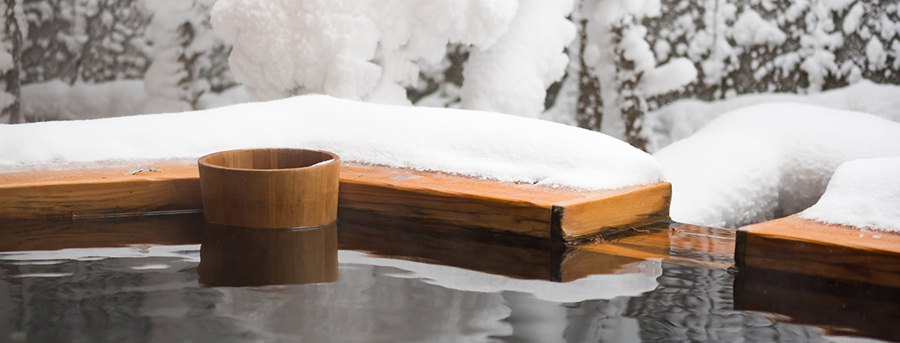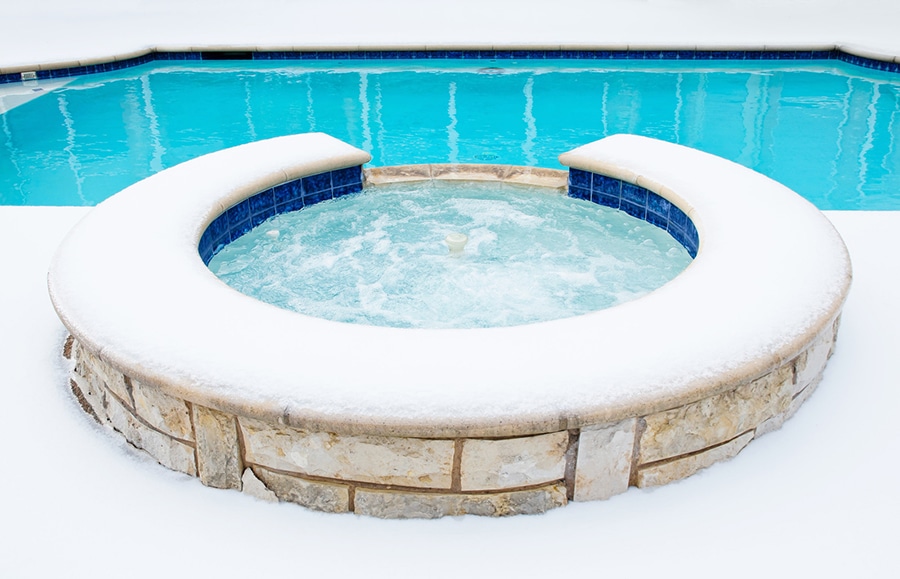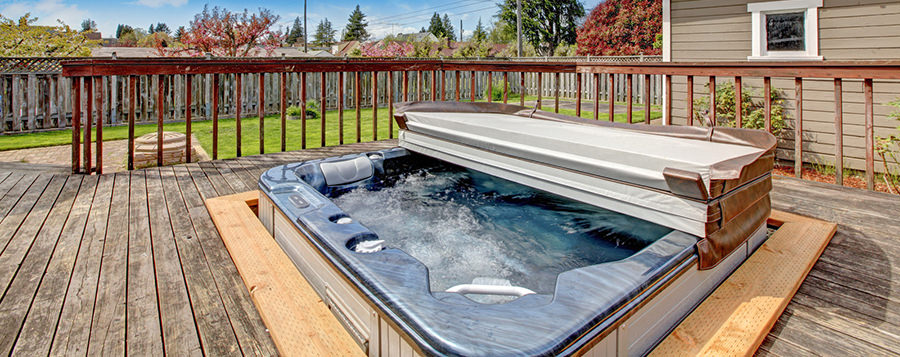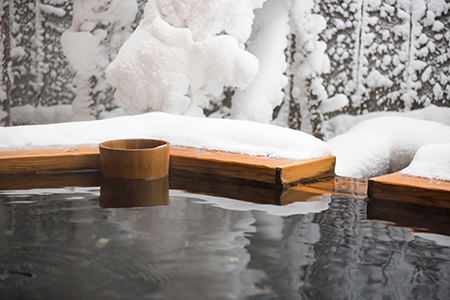
With Winter on it’s way you may well be thinking about preparing your hot tub for the winter months. You will have to decide whether to keep it running or to winterize your hot tub and wait for the spring thaw. I have been doing quite a lot of reading on the subject and, unsurprisingly, a lot of hot tub manufacturers recommend paying for a professional to come out and winterize your hot tub for you. But, is it really that hard and is it possible to get your hot tub ready for winter yourself? I decided to find out.
So, how do you winterize a hot tub? To prevent damage by freezing over winter the hot tub must be completely emptied of all water. This includes water in the components and pipes beneath the hot tub as well. After draining, blow out all of the pipes and jets, remove all hoses and let the water drain out. Completely clean and dry the hot tub and the cover securely for the winter.
The problem is, that if there is any water left in the hot tub pipes, pump or heater, and the water freezes, there’s a significant risk that it will damage your hot tub. Water expands by around 9 – 10% in volume when frozen and if it is in a confined space it will force it’s way out cracking anything that tries to prevent it. Just think of how frozen water can crack rocks, damage brickwork and roads and you will realise that your hot tub doesn’t really pose any challenge to it’s destructive power. Freeze-damaged hot tubs also tend to be expensive to repair as the water usually freezes in major components like pumps and heaters and these are expensive to replace. So, it’s really important, if you aren’t going to be using your hot tub over the winter, to plan ahead and take the time to winterize it properly.
Winterizing your hot tub step by step
Plan and prepare carefully – You can hire a professional to do the job for you because it is quite a long and time-consuming process. It also has to be done correctly to avoid frost damage to your hot tub so, if you are in any doubt as to whether you have the time, skill or inclination to winterize your hot tub yourself then having the peace of mind of a professional job might be the way to go. However, with some careful planning, it is possible to do it yourself and this method can be much more satisfying! So, put aside a morning or afternoon, preferably on a sunny day, where there is no risk of frost.
You will need:
A sump pump and/or hose to drain the water.
A wet and dry vacuum cleaner or some other way of blowing and sucking air through the pipes like an air compressor or possibly garden leaf blower.
Filter cleaner
Hot tub cleaner
Old towels and cloths
- Switch off the electrical supply – Completely remove the electrical connection for the hot tub either at the circuit breaker if it is a permanent installation or by removing the plug.
- Drain all of the water out – Remove the drain plug and let the water drain out. Some hot tubs allow you to attach a hose to the drain plug so that you can direct the water away off the patio or immediate area of the hot tub. Remember, in some places you are not allowed to drain hot tub water into public drains so maybe sprinkle the lawn or garden instead! If you want to be super sure you can use a flushing product before draining the water, put the jets on full for 20 minutes to flush any dirt out into the water and then drain it. This will clean out the inner workings and help to prevent any build up of bacteria whilst the hot tub is out of use. If you want to drain the water out more quickly, as it does take quite some time if you just let gravity take it’s course, you can use a sump pump and this will do the job much more quickly. After all the water is drained leave the drain plug out.
- Get the water out of the air blower – Switch off the heater. This is vitally important as the heating element will be damaged when you switch the hot tub back on as there isn’t any water in it. So, switch the heater off, replace the cover on the hot tub and then switch the electricity back on to the hot tub. Put the air blowers on (if you have them) to blow out any remaining water from the channels inside the hot tub. Once you have done this disconnect the electricity supply again.
- Take the filters out and clean – Next, remove the filters and clean them. Check the filters thoroughly for any signs of wear or damage before giving them a good clean. Is your filter due to be replaced? If not then give it a good clean with a hose or wand and then do a 24-hour soak. Give the filter a thorough rinse after the soak before drying and putting into storage. Once the filters are out, check the housing for excess water and vacuum up any remaining water or soak it up with towels. It’s important that you leave the filter housing completely dry and clean for the winter.
- Drain the pump and heater – Open up the cabinet below the hot tub and look for any quick release connectors holding water hoses to the pump or heater. Disconnect as many as you can. As you disconnect them water will come out of them draining the components – this is a good thing and you should leave them disconnected for the winter. You might find that there are drain plugs on the components as well. If this is the case then unplug them to allow the water to drain out. Again, leave the drain holes open for the winter and keep the plugs in a safe place along with the main drain plug for the hot tub.
- Blow out the jets – Next, you need to use your vacuum/leaf blower and blow out every single jet. Get into the hot tub and methodically blow air into every single jet starting with the one nearest the exhaust port of the pump and working your way round. Make sure that the jets are fully open when you do this and any air intakes are closed. This will blow out any remaining water from the pipes and it will possibly come out beneath the hot tub through the disconnected pipes and into the hot tub itself. Once you have been around every jet once go round again just to make sure and to be sure that you haven’t inadvertently blown any water back into the system.
- Add antifreeze? – Now, using antifreeze seems to be a bit of a contentious matter. A number of people think that there’s no need and not any point. If you have completely drained the hot tub of water and you are sure there isn’t any water in it to freeze then there’s no point in adding antifreeze. It is also said to be very difficult to get out of the system in the spring. However, other people do recommend using it and adding it at this point in the procedure. You must use a propylene glycol antifreeze that is specifically designed for the job and the recommendation is to pour it into each of the jets and into as many of the open pipes that you can. So, it’s really up to you to make the decision to use it or not.
- Clean the hot tub shell – Use a hot tub cleaning solution and give the whole shell a thorough clean. Make sure you get into all of the awkward places and particularly clean beneath the water line where dirt can accumulate without being noticed. You might have to rinse off the cleaning solution with clear water once you have finished.
- Dry up any remaining water – This is your last chance to go round the hot tub and to dry up all of the remaining water. Take your time and make sure that everything is as dry as you can get it.
- Cover the hot tub – Replace the thermal cover and, if you are expecting heavy snow, put plywood sheets over the top to help spread the weight. It is also a really good idea to have a full winter hot tub cover or to use a heavy weight tarpaulin. This will protect the sides of the hot tub from the winter weather as well as keep the whole thing weather and particularly windproof. Make sure that the cover is firmly strapped or weighted down.

Can I use my hot tub in winter?
So, that seems like quite a lot of hassle to go through to get your hot tub fully winterized!
Is there an alternative? Well yes! The obvious solution is simply to keep the hot tub open over the winter and to get good use of it all year round. Bear in mind that it will probably take a half day or so to properly winterize the hot tub for the four or five months of winter so you have to wonder if it is time well spent? Modern hot tubs are intended to run 24/7 all year round and in many ways, it makes economic sense to keep it going too.
The main expenditure you have made is the purchase and installation of the hot tub itself. You could argue that, if you are only using it for two-thirds of the year, then you are effectively wasting the money that you spent during those months when it’s not in use. Of course, the hot tub will cost money to run over winter but modern hot tubs are very well insulated and efficient and it most probably won’t cost much more to run in the winter months than in the summer.
Many hot tub owners also absolutely love the experience of being in the tub in winter. The combination of cold or even frost and snow on the face whilst your body is submerged in lovely hot water is wonderful! In fact, the hot/cold mixture is incredibly pleasurable and an opportunity not to be missed. Yes, you have to be a bit brave to go out in the elements to get into the tub (and getting out can be a little bracing as well!) but it’s well worth it and an exhilarating experience. There’s also something magical about hot tubbing on winter nights with the tub illuminated and the stars above your head!
The other alternative to fully winterizing your hot tub is a sort of halfway house between putting your hot tub into hibernation and keeping it switched on ready for action. If you know that you won’t be using your hot tub as often as you would do in the summer this can be a really good solution. Rather than draining the hot tub and switching it off you can save energy by reducing the temperature by up to 10 degrees for long periods of time when you know that you won’t be using the hot tub. Then, the day before use turn it back up again. Now, generally speaking this isn’t a great idea as it does use quite a lot of energy to reheat the tub but, if you know that you’re not going to be using it on a regular basis throughout the winter, this can be a good solution. As long as the water temperature is above freezing and the jets are keeping the water moving there is no risk of freezing. However, if you know for a fact that you will not use your hot tub for more than 3 to 4 weeks over the winter then it’s probably more economical to fully winterize it during this period. The choice is yours and it’s a case of balancing up the time it takes to winterize the hot tub against the economy you will make in terms of saving electricity.

Starting the hot tub up again in spring
Ah great joy! The winter is over, Spring is in the air and it’s time to get the hot tub up and running again for a glorious relaxing summer of soaking! Here’s how to do it:
- Remove the cover – Unwrap the hot tub from it’s hibernation and check for any leaks or places where debris might have blown in. Have a good clean and sweep around the hot tub area and store away the winter hot tub cover. You will also need to find the drain plugs that you safely put away when you got the hot tub ready for the winter.
- Reconnect everything – Reconnect all of the pipes inside the cabinet making sure that the connections are secure. Take your time over this and make sure that you don’t miss any. You also need to replace all of the drain plugs at this point.
- Fill the hot tub – Fill the hot tub with cold water. Check that everything is clean beforehand as there’s little point in filling a dirty hot tub with clean water. If you did a good job with the winterization process there shouldn’t be any issues but it’s possible that water or dirt might have leaked in at some point during storage.
- Run the jets and turn the air on and off – This will make sure that the water is in all of the pipes and there aren’t any air locks. Whilst you are doing this check for leaks underneath the hot tub particularly at the hose connections where you have just reconnected them.
- (Optional) Drain and refill – If you used antifreeze over the winter it’s now vital to refill the hot tub and then to rinse it out before refilling with clean water. Follow the antifreeze instructions but it’s vital to get rid of all traces of it.
- Replace the filters and check the water level – Check that the water is at the recommended level and make sure that you put clean filters in.
- Add chemicals and heat – Finally, you can follow your normal procedure in terms of filling with chemicals and reconnect the hot tub before switching on and waiting for it to heat up ready for another summer of relaxation!
Related Questions
How long does it take to heat up a hot tub? This depends upon the ambient heat of the water when you put it in the hot tub, how much water there is and how powerful the heater in the hot tub is. As a rough rule of thumb it will heat between 2 and 3 degrees C per hour to it’s operating temperature which is likely to be between 37 and 40 degrees C. It’s usually best to let the hot tub just heat up overnight. It will heat up more quickly and retain it’s heat better with a thermal cover over it.

